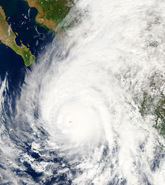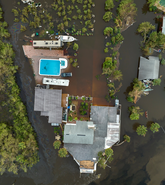We recently brought together thought leaders from across Moody’s to talk with the media at our 2023 Hurricane Season Recap and 2024 Outlook briefing, to provide a range of perspectives from meteorology to market impact.
We looked back at the 2023 hurricane season, together with overall natural catastrophe activity for the year, and looked at what 2024 may have in store, to gauge the possible impact on the insurance industry.
Looking at 2023, we saw a North Atlantic Hurricane season that produced twenty named storms – the fourth most active season on record, but it was only Hurricane Idalia that caused any significant impact in the U.S.
For the Eastern North Pacific Basin, the 2023 season produced seventeen named storms, and eight major hurricanes. Over 25 days in October, four tropical cyclones impacted the west coast of Mexico in quick succession, with Hurricane Otis by far the most impactful; an unprecedented, rapidly intensifying category 5 storm that caused significant damage to the Acapulco area.
The 2024 North Atlantic hurricane season doesn’t officially begin until June 1, but we wanted to explore whether there were any early signals in terms of the type of season that might be ahead, and what the industry might need to look out for.
Idalia: Highest Loss Hurricane in the 2023 North Atlantic Season
2023 was the fourth year in a row where global insured losses crossed over the US$100 billion line, according to some market estimates. Instead of hurricanes dominating the picture as we have seen in recent years, severe convective storms (SCS) made up the majority of the losses – with reinsurers suggesting estimates as much as US$60 billion.
For comparison, Hurricane Idalia – the only landfalling U.S. hurricane in 2023 – is estimated by Moody’s RMS in the US$3-5 billion loss range.
Our thought leaders discussed how insurers with exposure in hurricane-prone states like Florida, breathed a slight sigh of relief from the lack of impactful, landfalling hurricanes during 2023, restoring some calm to the state’s insurance market.
On the heels of significant reforms aimed to curb the impacts of social inflation, Florida is starting to show signs of stabilization. At least six new entrants have been approved already in 2024, and state-managed Citizens is expecting depopulation efforts to continue throughout the year.
However, insurance challenges remain. Significant cumulative losses coming from high frequency/lower loss SCS events are being absorbed by primary carriers. These ‘non-peak’ peril cumulative losses are eating into earnings, with some homeowners carriers running above 100 percent combined ratios, with ongoing efforts to restore profitability.
For many carriers, individual SCS event losses do not reach occurrence attachment points for reinsurance layers. To stem losses and return to profitability, carriers have passed through rising premium prices, tightened terms and conditions, and even withdrawn coverage in some areas.
These actions are having wide ranging impacts for the broader economy. For example, rising insurance premiums and tightening coverage availability are also presenting challenges for commercial real estate transactions, particularly in catastrophe prone areas.
Early Look at the 2024 Hurricane Season
Looking ahead to the 2024 North Atlantic hurricane season, which at this stage is still difficult to do with much certainty, sea surface temperatures (SSTs) in the North Atlantic, similar to 2023, remain high, even through this winter.
Examining Pacific SSTs, for the El Niño–Southern Oscillation (ENSO), predictions show a likely transition to neutral phase or just into La Niña phase as we get near to the start of the season. Typically, these conditions result in a more active North Atlantic basin, but there is significant uncertainty at this lead time.
Regardless of how favorable (or unfavorable) conditions are in the Atlantic this year, the mantra remains that it only takes one major event to define a season. Therefore, it is important for firms to be prepared for any and all scenarios, and to have their event response teams in place to respond if and when an event occurs.
In parallel to monitoring the potential drivers of the upcoming season, 2024 will allow us to continue learning from past events. Our thought leaders agree that Hurricane Otis, and its rapid intensification and subsequent impact to coastal Acapulco, offers a unique opportunity to examine extent and severity of damage, and to better understand how a Category 5 storm affects densely populated urban environments.
Key Takeaways
Three main points became clear as we now move closer to the 2024 hurricane and SCS seasons. First, managing hurricane risk requires the use of a model that reflects the latest view of the hurricane risk landscape, especially as treaty renewals come into view, to ensure treaty structures reflect the full extent of research, data, and learnings that drive hurricane frequency/severity relationships.
Our second point is the recognition that severe convective storms continue to represent a significant proportion of insured losses.
Even without a major landfalling U.S. hurricane in 2023, the total level of global insured losses for the year still exceeded US$100 billion. Losses could reach new heights if we have another year of SCS losses similar to 2023 plus an active hurricane season with multiple impactful U.S. landfalling events.
Severe convective storm events benefit from the same sophisticated risk modeling as hurricanes and earthquakes, and this could help primary carriers to more effectively negotiate and structure reinsurance or insurance-linked securities (ILS) capital.
Finally, there is a need for carriers to return to profitability and reduce combined ratios – rebuilding after rising losses is a main focus. Premiums have recently risen, terms and conditions tightened, and coverage in some geographic areas has been withdrawn.
These short-term tactics need to shift to a longer-term, sustainable approach for carriers, where risk is priced to reflect loss costs, more risks benefit from external capital, and innovations – such as our forthcoming advanced SCS modeling built on our cloud-native platform, can give the market deep insights so it can get on a more secure footing.
Our Event Response team will ensure our clients and the wider market are kept informed of the latest events throughout the season, find out more here.










